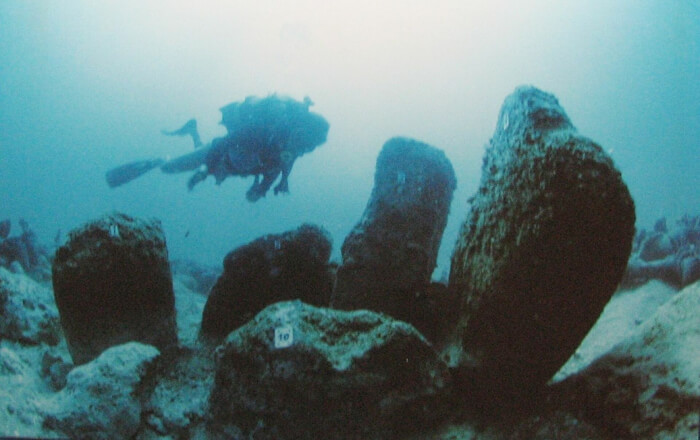Ancient Submerged Neolithic Village With Mysterious Stone Circle
Appearing to be a one-phase settlement, Atlit-Yam represents a short period of occupation before the sea encroachment leading to the abandonment of the village around 6300 BC. Its current location is off the coast of Atlit in present-day Israel.
Swamps along the Israeli coastal plain, under the influence of tectonic tilting and climate changes, began to evaporate at the beginning of the Holocene.
Neolithic people settled in the reclaimed land along the retreating shoreline during the Pre-Pottery Neolithic B (PPNB) and later Pottery Neolithic Periods until a rise in eustatic sea levels submerged the ancient settlements to a depth of 26-39 ft. under the surface.
Scientists believe that Atlit-Yam was abandoned abruptly as a result of a tsunami that hit the region, most likely caused by a volcanic eruption in the Mediterranean area.
 Source: Creativecommons
Source: Creativecommons
Atlit-Yam, underwater ritual structure made of stones.
The site, dating back to 6900 – 6300 BC, locates at a depth of 32 ft under sea level and covers an area of 430,556 square ft.Swamps along the Israeli coastal plain, under the influence of tectonic tilting and climate changes, began to evaporate at the beginning of the Holocene.
Neolithic people settled in the reclaimed land along the retreating shoreline during the Pre-Pottery Neolithic B (PPNB) and later Pottery Neolithic Periods until a rise in eustatic sea levels submerged the ancient settlements to a depth of 26-39 ft. under the surface.
 Source: Wikimedia Uploads
Source: Wikimedia Uploads
The location continued to be uncovered 32 ft below sea levels for hundreds of years, only to be found following an extreme storm in 1984, when archaeologists discovered particular stones used for religious ceremonies.
The Neolithic humans settled at Atlit Yam around 6900 BC, surviving on agro-pastoral-marine subsistence. Source: Wikimedia Uploads
Source: Wikimedia Uploads
Over 8755 flint artefacts have been retrieved in one single assemblage, together with the excavation of several arrowheads, sickle blades, bifaces, spearheads, and bi-facially flaked knives across the site.
 Source: Pinterest
Source: Pinterest
A well with the depths of up to 34 ft. was dug through layers of clay and soft sandstone, limed with stone courses and capped with a tumulus-like circular construction. Archaeologists discovered hundreds of thermally fractured lime stone pebbles within the build-up of marine sediment inside the well, alongside animal bones, stone tools, waterlogged and carbonized plant remains, and several fragments of human bone.
Atlit-Yam is believed to have been deserted suddenly and unexpectedly as a consequence of a tsunami hitting the region, possibly from a volcanic eruption in the Mediterranean area, according to experts.Scientists believe that Atlit-Yam was abandoned abruptly as a result of a tsunami that hit the region, most likely caused by a volcanic eruption in the Mediterranean area.
 Source: Wikimedia Uploads
Source: Wikimedia Uploads
Human skeleton in flexed position, discovered at Atlit-Yam. Close to or within the ritual structures, 15 human skeletons have been discovered, mostly in single graves either relatively intact, or only a few bone fragments, all of which show varying degrees of hypoplasia.
The findings of two skeletons, including the bones from a woman and a child exceptionally caught archaeologists’ attention as they uncovered the earliest acknowledged cases of tuberculosis.Share this article
Advertisement